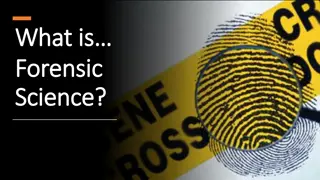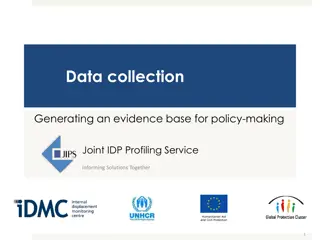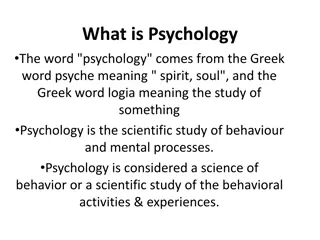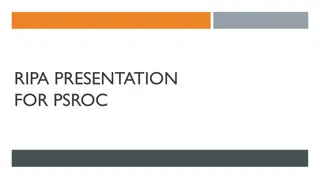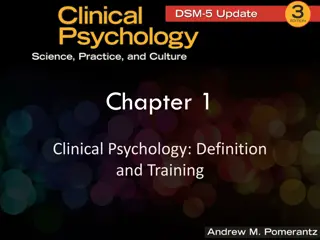Understanding Profiling in Forensic Psychology
Explore the concept of profiling in forensic psychology, including its techniques, history, and applications in criminal investigations. Learn about the various categories of profiling and the role psychologists play in identifying unknown individuals based on behavioral patterns and characteristics. Delve into the challenges and benefits of profiling in aiding law enforcement agencies to solve crimes.
Download Presentation

Please find below an Image/Link to download the presentation.
The content on the website is provided AS IS for your information and personal use only. It may not be sold, licensed, or shared on other websites without obtaining consent from the author. Download presentation by click this link. If you encounter any issues during the download, it is possible that the publisher has removed the file from their server.
E N D
Presentation Transcript
INTRODUCTION TO FORENSIC PSYCHOLOGY Psychology of Investigations Chapter 3 Brittany Perrotta, LMHC CASAC-T
CLASS AGENDA Chapter 3 Explore ways psychologists contribute to criminal investigations. Describe and differentiate the five types of profiling. Examine the limitations and problems of profiling. Discuss types and incidents of false confessions. Review detecting deception. Review eyewitness identification. Examine the psychology of pretrial id methods
THREE MAIN QUESTIONS 1. What are the important behavioral features associated with the crime that may help identify and successfully prosecute the perpetrator? 2. What inferences can be made about the characteristics of the offender that may help identify him or her? 3. Are there any other crimes that are likely to have been committed by the same perpetrator?
https://www.youtube.com/watch?v=nux A6YgBtNU
Profiling is the technique that attempts to identify the behavioral, cognitive, emotional, and demographic characteristics of a person based on information gathered from a variety of sources. It is a process that can be used to identify an unknown individual and can sometimes be used to chronical the behavioral patterns, thought processes, and emotional characteristics of a known person.
PROFILER VS. BEHAVIORAL ANALYST PROFILING VS. CRIMINAL INVESTIGATIVE ANALYSIS
PROFILING CATEGORIES Criminal profiling Geographical profiling Suspect- based profiling Psychological profiling Psychological autopsy
BRIEF HISTORY OF PROFILING Criminal profiling is assumed to have been developed by the FBI in 1970s Assistance with cases of serial homicide and serial rape FBI Behavioral Science Unit New York s Mad Bomber 1950s David Canter s contribution to the field Center for Investigative Psychology An actuarial or statistics- based method
HOW PROFILING DIFFERS FROM THE USUAL TASKS OF PSYCHOLOGISTS?
Psychologists are given ambiguous, sometimes unreliable, and incomplete material to work off of when profiling. In a typical task of a psychologist they use a biopsychosocial and inventories/ questionnaires to get a full picture of an individual. The suspect profile must be usable for investigators. Profiling is not limited to serial offenses, can be beneficial in cases of arson, burglary, white-collar crimes.
Requires the development of describing some of the key behavioral, cognitive, emotional, and demographic features of an unknown person. Evidence is gathered at the crime scene and reports from victims or witnesses allow a profile sketch to form. profilers use this information to predict characteristics and habits of the offender and how the next crime may occur. Profiling is used when there are a limiting number of clues and there is little progress in identifying a potential suspect.
person is likely to be a young, unmarried, male, blue,-collar worker who is a substance abuser may be even more likely to be a middle- aged loner with a steady income who stays isolated Linkage analysis: method of identifying crimes that are likely to have been committed by the same offender because of similarities across the crimes.
MYTH FACT Profilers get into the mind of the suspect. More to do with discovering how victims are chosen, how they are treated, and what forensic evidence is there to use as assistance. Profilers make predictions about a suspects personality. Stating someone is a narcissistic vs. behaviors of a narcissist. What is more helpful? Lacks reliability and validity. Established scientific enterprise.
PROFILERS CAN RARELY DIRECTLY POINT TO THE PERSON THAT COMMITTED THE CRIME! PROFILING IS NOT A FREQUENT ACTIVITY OF POLICE AND PUBLIC SAFETY PSYCHOLOGISTS.
GEOGRAPHICAL PROFILING AND CRIME MAPPING
Geographical profiling: Focuses on the location of the crime and how it relates to the residence or base of operations of the offender. Refers to a single offender. Geographical mapping: Concerned with analyzing the spatial patterns of crimes committed by numerous offenders over a period of time. Focuses on identifying the hot spots of certain types of crime.
Geographical profiler aims to focus on identifying the approximate location of the offender s residence, the base of operations, and where the next crime may occur. Criminal profiler focus on the motivational, demographic and psychological features of the offender.
WHEN IS GEOGRAPHICAL PROFILING USED? A series of crimes are occurring Arsons, sexual assaults, bombings, bank robberies, child abductions, murders
GEOGRAPGICAL PROFILING AND ITS PSYCHOLOGICAL CONNECTION Offender s operating within their comfort zones or feeling the need to be as far away from one s residence as possible.
HUNTING PATTERNS 1. Hunter: those criminals that specifically set out from their residence to look for victims, looking in their awareness spaces for those that would be a suitable target. Tend to be geographically stable and often occur near the place of residence/ neighborhood. 2. Poacher: More transient offender, traveling a far distance from their residence or neighborhood.
3. Troller: Dont specifically search for their victims, but rather randomly encounter them during the course of some other activity. 4. Trappers: Create situations to draw victims to themselves. Entertaining, ads, positions/ occupations where an individual comes to them.
Criminal Geographical Targeting: topographical map assigning different statistical probabilities to areas that fall within an offender s territory.
SUSPECT- BASED PROFILING
Process of collecting behavioral, personality, cognitive, and demographic data on previous offenders in an attempt to identify other offenders. The suspect-based profile can summarize the psychological features of individuals who may commit a crime based on features of past offenders who have committed similar crimes.
Various offender groups can be profiled. Ex. Different types of sexual assault offenders. Example used in the text Someone driving at a certain speed, at a certain time of day, in a certain type of car, and of certain general appearance may fit the profile of a drug courier and be stopped for a search.
Issue lies in the general appearance approach which can refer to suspicious behavioral patterns, manner of dress, and unfortunately race or ethnicity. Racial profiling: police- initiated action that relies on the race, ethnicity, or national origin rather than the behavior of an individual or info that leads police to a particular individual. Profiling of this type is illegal! Courts have determined that police action cannot be taken against a person off the sole basis of their race or ethnicity.
Airline security procedures following the events of September 11th, 2001 Jihad Jane Behavioral scientists were asked to supply more research to help airline security identify potential terrorists from passengers in airports. These suspect-based profiles will be based on dress patterns, buying habits, and the cultural and social backgrounds of previous airline terrorists. Look at the facial expressions and suspicious behavior patterns. Every 9 out of 10 persons have a perfectly good reason for their suspicious behavior.
PSYCHOLOGICAL PROFILING
The gathering of information on a known individual(s) who pose a threat or is believed to be dangerous. The identity of the individual can sometimes be unknown, but the person has made some sort of threat to a specific target.
Two types of procedures: Threat assessment: determination if an actual, expressed threat is likely to be carried out. Risk assessment: determination if a person is dangerous to self or others. These assessments are made up of evaluation measures, background checks, observations, and interviews. This type of profiling can also be used to prepare profiles on specific types of offenders. (child molester, the firesetter)
PSYCHOLOGICAL AUTOPSY
Procedure that occurs to make a reasonable determination of what may have been in the mind of the deceased person leading up to and at the time of death. This type of profiling typically occurs when there is an apparent suicide. Assisted in clarifying deaths that were initially ambiguous, uncertain, or equivocal as the manner of death.
Equivocal death is one in which the manner is unknown or undetermined. Two types of psychological autopsy: Suicide psychological autopsy: suicide is established and the psychologist is investigating to identify and understand the psychosocial factors that contributed to the suicide. Equivocal death psychological autopsy: to clarify the mode of death and to determine the reasons for it. Psychological autopsies are typically done for insurance purposes.
The military conducts an EDPA for every equivocal death and suspected suicide that occurs. In legal contexts the psychological autopsy is done to evaluate the reasons for a suicide to see if there is legal culpability on the part of other persons or organizations. Where there any early-detection procedures or stress- management techniques? Do certain aspects of a job affect persons? Did the job adequately handle harassment issues/ have proper policies in place?
WHAT DOES IT ENTAIL? Interviews with family members, friends, acquaintances, supervisors, teachers, mental health professionals, physicians, and coworkers. Any substance abuse issues, mood or emotional changes, psychological stressors. A comprehensive report is written describing the relevant factors and significant events prior to the death. An opinion is often included about the mode of death. Pre- death behaviors are also listed: Paying insurance policies, writing notes Quality of relationships
Psychologists performing psychological autopsies cannot make conclusions about the precise mental state or actions suspected at the time of death.
LIMITATIONS OF PROFILING
The assumption that human behavior is consistent across various situations. The assumption that the offense style or crime scene evidence is related to specific psychological characteristics. Profilers tend to rely on unsupported hypotheses about personality theory and that personality types will override the influence of all situations. gut feelings
The power of the situation and the victim. Incorporating victimology can have improvements in the success of profiling. Profiling and it s use in the judicial system. In U.S. depends on the profilers credentials and the ability to persuade the court that there is scientific reliability and validity to their profile.
Trans-temporal consistency: Tendency of people to exhibit the same behavior and tendencies across time. Ex. A person who engaged in a lifetime of burglary is likely to burglarize again if surrounded by similar psychosocial situations. Trans-situational consistency: Tendency of people to exhibit the same behavior and tendencies across different situations. If an offender recognizes some behavioral patterns don t work, they will likely change their modus operandi.
Some profilers will interpret the ambiguous information to fit their own biases about the suspect. They will select certain aspects that they find fitting while ignoring the many conclusions and predictions that are contradictory.
POLICE INTERVIEWING AND INTERRORGATION
Primary aim of police interrogation is to obtain a confession from a suspect or to gain information that may lead to a conviction. Skillful and legally useful interrogation involves the application of psychological principles and concepts.
Accusatorial approach: an aggressive questioning procedure that assumes the suspect is responsible for a criminal offense and has the goal of obtaining a confession. Information- gathering approach: this approach does not presume guilt on the part of the person being questioned, but rather seeks to obtain information about events surrounding a crime.
REID METHOD Interview interrogation Highly confrontational Interrogator vs. Suspect Direct purpose is to obtain confession rather than gather information Interrogator maintains the control Asks only yes/no questions



